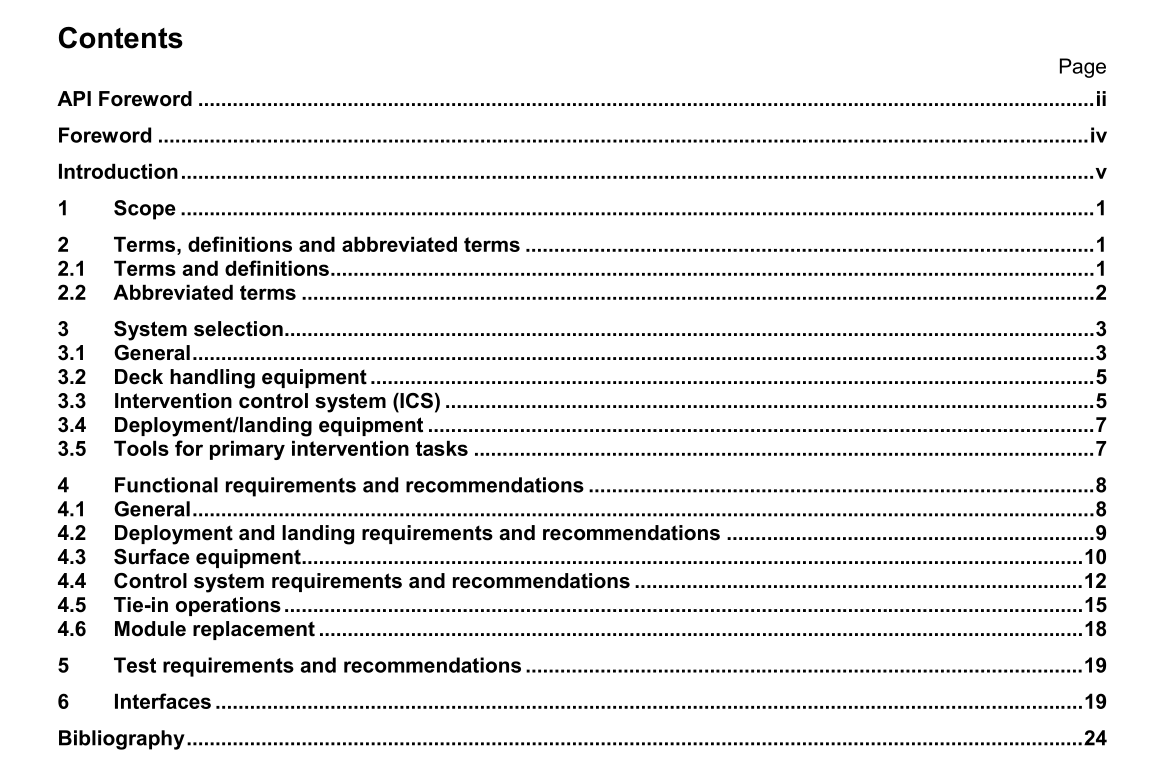ANSI API RP 17M pdf download

ANSI API RP 17M pdf download.Petroleum and natural gas industries — Design and operation of subsea production systems
1 Scope
This part of ISO 1 3628 provides functional requirements and recommendations for ROT intervention systems and interfacing equipment on subsea production systems for the petroleum and natural gas industries. This part of ISO 1 3628 does not cover manned intervention and ROV-based intervention systems (e.g. for tie-in of sealines and module replacement). Vertical wellbore intervention, internal flowline inspection, tree running and tree running equipment are also excluded from this part of ISO 1 3628.
2 Terms, definitions and abbreviated terms
For the purposes of this part of ISO 1 3628, the following terms, definitions and abbreviated terms apply. 2.1 Terms and definitions 2.1.1 subsea intervention all work carried out subsea 2.1.2 primary intervention all work carried out during the scheduled intervention task 2.1.3 ROT system dedicated, unmanned, subsea tools used for remote installation or module replacement tasks that require lift capacity beyond that of free-swimming ROV systems NOTE The ROT system comprises wire-suspended tools with control system and support-handling system for performing dedicated subsea intervention tasks. They are usually deployed on liftwires or a combined liftwire/umbilical. Lateral guidance may be via guidewires, dedicated thrusters or ROV assistance. 2.1.4 deployment system all equipment involved in the launch and recovery of the ROT system 2.1.5 heave-compensated system system that limits the effect of vertical vessel motion on the deployed ROT system2.1.6 skid system storage, transportation, lifting and testing frames to facilitate movement of the ROT systems and the modules and components to be replaced or installed NOTE Skids are used in combination with a skidding system. 2.1.7 sealines all pipelines, flowlines, umbilicals and cables installed on the seabed 2.1.8 termination head part of the PICS interfacing with the end of the sealine 2.1.9 pull-in head part of the pull-in system acting as attachment point for the end of the pull-in wire
3 System selection
3.1 General The design, configuration and operation of the ROT intervention system impacts directly on the LCC for the entire SPS. In order to obtain an SPS design providing safe and cost-effective intervention operations, it is important to obtain a closed loop between SPS design and intervention system design. See Figure 1 . An ROT intervention system typically comprises the following: a) ROTs for dedicated intervention tasks, b) deck handling equipment, c) ICS, d) deployment/landing equipment, e) ROV spread interfaced with ROT systems. An illustration of the main features of an ROT intervention system and associated equipment is shown in Figure 2. The breakdown of the ROT intervention system into sub-elements and components as presented in this part of ISO 1 3628 should not pose limitations on the selection of new intervention concepts whose functionality and reliability can be documented. Configurational options for the ROT intervention system and interfacing equipment, such as intervention vessel and ROV systems when used, are shown in Figure 3.
4 Functional requirements and recommendations
4.1 General This subclause contains general functional requirements and recommendations for the elements within the various options of ROT intervention systems and interfacing equipment. a) The ROT intervention system shall be designed to be as small, simple, reliable and robust as possible, to ensure safety of personnel and to prevent damage to the intervention system, the SPS and/or the environment. No single failure should result in reduced safety for the involved personnel, or cause damage to involved equipment and/or the environment (consider redundancy in order to minimize the probability of failure). b) The ROT functional requirements shall reflect its multiple use over the design life of the SPS. c) The ROT intervention system shall be designed to allow for safe and easy operation, maintenance, repair and replacement of components. d) Operations of all functions in the ROT intervention system shall be optimized with regard to duration. e) Priority should be given to reduce the time required for mobilization/demobilization onboard the intervention vessel. f) Functionality and operability of new ROT intervention concepts shall be documented in design and by testing under realistic conditions. g) All intervention tasks shall be possible to suspend in a safe manner. It shall be possible to resume a task suspended due to equipment failure or adverse weather conditions. h) All ROT operations should be fully reversible at any stage.









